|
Pioneer
Cemeteries and Their Stories, Madison County, Indiana |
 |
|
Pioneer
Cemeteries and Their Stories, Madison County, Indiana |
 |
aka Oddfellows/Oldfellows
Location: east side of SR 9, between 4th and 5th streets in Alexandria
 |
|
Started during the time of the earliest settlers to the Alexandria area, the original graveyard at this location was taken over by the IOOF sometime around 1860. This benevolent organization added to and beautified the grounds and operated the cemetery as a "permanent and lasting resting place for the departed, of those in as well as out of the order." This cemetery is still one of the prettiest in the county and one of the most visible. The picture above features the veterans' memorial as seen from SR 9, the fall foliage of the trees, and the evergreens planted in 1860. The IOOF Cemetery is still in use. |
The International Order of Odd Fellows, IOOF, a group devoting themselves to good works, began in England in the last part of the 18th century and spread into the United States in 1818. The first lodge of this benevolent organization in Madison County was started in Pendleton in 1850. By the end 1860, the Necessity Lodge No. 222 was initiated in Alexandria with ten charter members whose last names are of families who helped settle Monroe Township: Heagy, Harriman, Chamness, Pickard, etc. As part of its involvement in the community, IOOF No. 222 purchased land southeast of Alexandria with plans to design a large cemetery "conducted on modern principles." Part of the original twenty-five acres purchased must have already been in use as a burial site since there are legible gravestones with death dates preceding 1860 in the oldest section of the present IOOF Cemetery. The IOOF board of trustees had the property landscaped with trees, evergreens, and drives, making the cemetery, according to Forkner in his 1914 history, "one of the prettiest in Madison County."
By mid 20th century, the cemetery had been turned over to the Monroe Township trustee and was in need of restoration. The restoration, including the resetting, cleaning, and re-incising of stones, was accomplished by 1990. Examples are shown at right and left. The old burial site, once quietly ensconced along a wooded strip of the Anderson-Alexandria Pike, is now a most visible landmark in the southern part of ever-expanding Alexandria. The pike has turned into busy SR 9, and the oldest section of the burial ground now abuts the it. Many graves are within a foot or two of the pavement. For this reason, member of the MCCC (2006) Nancy Draper has recommended to highway improvers that a cement curb be placed between the highway shoulder and cemetery border.
|
Decked out for Memorial Day, the IOOF Cemetery always provides a festive, patriotic display for motorists along SR 9 and Alexandria's residents. The oldest section can be seen in the background, and it is the part closest to the highway. The stone in the right foreground commemorates the cemetery's renovation in 1990. |
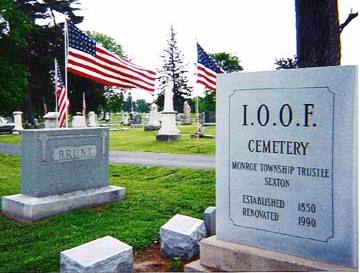 |
Some of the earliest graves, from before the IOOF incorporated the burial ground in 1860, are Mary Hannah, who was born in April of 1803 and died in 183?; Beth Hartman, who died August 25, 1831, at eleven months; Lathrip Delforce, who was born in1816 and died in1836; A.W. George, who died October, 4, 1839; Michael Loubes, whose birth and death dates are the same: August 13, 1843; John Westerfield, who died October 16, 1844, at eleven months and eleven days; and Sarah Lee, who died April 18, 1849.
Possibly the person with the earliest birthday buried here is Elizabeth Herritage, who died January 14, 1842. She was "82y 3m 10d," making her birth date in 1760. Also born in the 1700s are Eleazer Carver, born November 22, 1788, died October 21, 1873, and his wife Elizabeth Carver, born June 5, 1795, died December 13, 1874. Their marker is pictured below.
|
|
The Carvers were from a large family who pioneered the northern sections of Madison County in the first third of the 19th century. Another branch of the family actually began the large Carver Cemetery in Boone Township. Here in Monroe Township's IOOF Cemetery, Eleazer and Elizabeth Carver's pillar is pictured left while the close-up of Elizabeth's data on the south face is at right. The stark white color and crispness of the stone's re-incised lettering are the result of the trustee's 1990 refurbishment of the earliest grave markers. |
|
|
|
|
|
Early 19th century citizens in and around Alexandria who rest at the IOOF are Frederick Black, left, who died November 1, 1876, at "69y 9m 15d"; Nathan Tomlinson, center, who died May 27, 1890, at "72y 7m 14d"; and George Painter, who died August 28, 1885, at "74y 2m 17d." George's beautifully restored stone is at right. Other early settlers on record are John Heagy, who died in 1861 at "53y" and Abram Miller, who died November 11, 1876, at "67y 7m 29d."
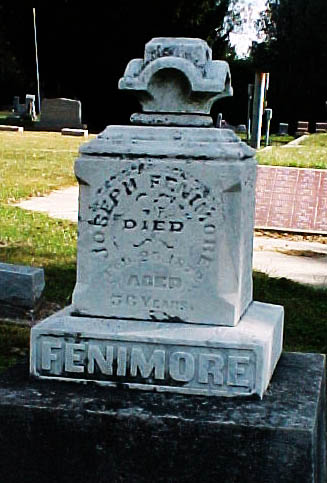
One of Alexandria's first
important craftsmen also rests here. Joseph Finnemore/Fenimore was a
blacksmith--a 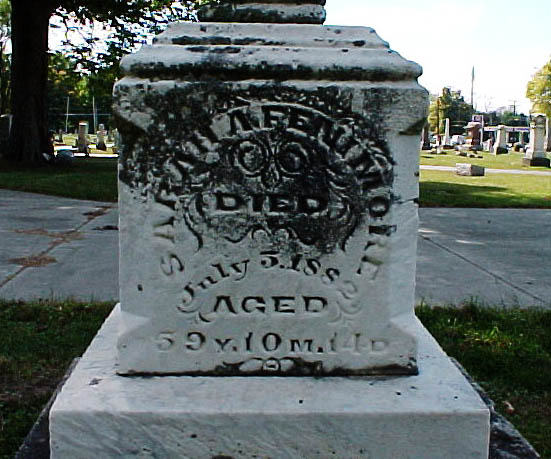 worker of iron and metals, maker of tools, and farrier to horses.
Joseph was born in Ross County, Ohio, February 25, 1816. In 1836 in Ohio,
he married Sarah Griffey, born on August 21, 1822, also in Ohio; they traveled
west together, settling where Alexandria was developing. Because of his
occupation, Joseph would have been a very important figure in the daily
activities of the community. Blacksmiths not only kept horses shod, and
therefore usable, but also made and fixed anything metal: farming and lumbering
tools, household utensils, lamps, door and window fixtures, parts to wagons and
wheels, etc. In other words, Joseph Finnemore, the area's first "smith," would
have been indispensable to a thriving community. Joseph and Sarah had ten
children: John, Lydia, Martha, Sarah, Daniel, Frederick, William, Joseph, Alice,
and Charity. Joseph, the father, was also one of the first members of the IOOF, and he
died on his fifty-sixth birthday, February 25, 1872. Sarah, who died July
5, 1882, is resting next to her husband.
worker of iron and metals, maker of tools, and farrier to horses.
Joseph was born in Ross County, Ohio, February 25, 1816. In 1836 in Ohio,
he married Sarah Griffey, born on August 21, 1822, also in Ohio; they traveled
west together, settling where Alexandria was developing. Because of his
occupation, Joseph would have been a very important figure in the daily
activities of the community. Blacksmiths not only kept horses shod, and
therefore usable, but also made and fixed anything metal: farming and lumbering
tools, household utensils, lamps, door and window fixtures, parts to wagons and
wheels, etc. In other words, Joseph Finnemore, the area's first "smith," would
have been indispensable to a thriving community. Joseph and Sarah had ten
children: John, Lydia, Martha, Sarah, Daniel, Frederick, William, Joseph, Alice,
and Charity. Joseph, the father, was also one of the first members of the IOOF, and he
died on his fifty-sixth birthday, February 25, 1872. Sarah, who died July
5, 1882, is resting next to her husband.
One of the earliest prominent settlers to Monroe Township buried at the IOOF is David Bowers. David was born in Pike County, Ohio, on July 12, 1811, the son of Solomon and Deborah Lyton Bowers, both of Virginia. In 1834, shortly after the first settler Micajah Chamness pioneered the township, David arrived ready to seek his future. David entered eighty acres in the same year and started to develop a homestead. Throughout his adult life, he purchased more property until he was the owner of three fine farms. In 1835, he married Susan Edwards, daughter of Peter Edwards, whose family had also settled early in the Alexandria area. Susan was born in Wayne County, Indiana, in 1813. Susan and David had one son, Andrew. She is one of the earliest burials, having died December 31, 1846, "38y 1m 25d." David then married Ellen Reed in 1853, and they had four children: Henry P., Susan, James E., Elizabeth, and David W. After Ellen passed away, David Bowers married for a third time. Mary Noble, daughter of pioneer William Noble, was born in 1829, and she and David had one son, Nathan.
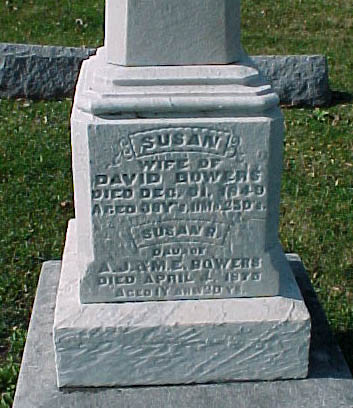 |
The bottom of the Bowers family stone shows the excellent resetting accomplished by the renovation finished in 1990. The stone's inscription also appears to have been re-cut. The words and numbers are very crisp; even the scroll decoration is sharp and clear. Another early burial, David Bowers' first wife Susan died in 1840. A granddaughter, also named Susan, is recorded on the stone as buried in the family plot. |
Historian Samuel Harden was a personal friend of David Bowers and provides this description:
"He has been an industrious, sober citizen, held in high esteem by his fellow-citizens who have known him so long. At one time he resided one mile and a half southeast of Alexandria, but now the town has grown almost to his door... In 1874, he bought my first book, and I am indebted to him for many favors shown me from time to time. In person Mr. Bowers is about five feet eight inches high, fair complexion, heavy set, inclined to be fleshy and will weigh near two hundred pounds."
David Bowers died in 1898. He, his wives, and some of his children are interred in the old section of the IOOF Cemetery.
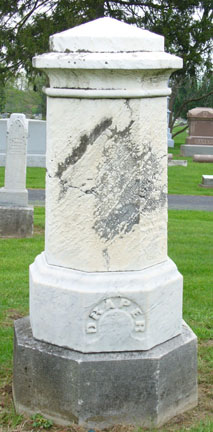
A later settler's family is represented by the octagonal drum style marker at right. Joseph Draper was born in Virginia December 17, 1828, to Thomas and Mary Turner Draper. Thomas's family moved west into Rush County, Indiana, first. Son Joseph later moved further west to five miles east of Alexandria with his third wife Anna Siler, born March 29, 1839, daughter of Jacob Siler. In 1895 historian Samuel Harden wrote of the couple:
"Children born to this marriage are: May E, born in Madison county, July 20, 1864... Martha J., born December 19, 1865... Peter T., born August 8, 1876... John W., born June 18, 1869...
"He [Joseph] and his wife [Anna] are industrious and have the confidence of the people where they have so long resided since 1862 when they came from Rush county, Indiana, and settled in the then new county. Mr. Draper has always been a stanch Republican and he and his wife belong to the Christian church. their home is one of plenty and they delight to entertain their many friends. Peter T., their son, who is a teacher of long experience, lives near the old folks..."
The Draper family still has descendants farming in Monroe Township.
Other early families to the township are witnessed by the stones below: left, "Malissa E. wife of Wm. A. Swindell, died Oct. 7, 1879"; center, "Joseph B. Williams died Feb. 1, 1872"; right, "father Gideon Keefer born Oct. 26, 1825 died Dec. 11, 1884."
|
|
|
|
|
|
|
|
|
Above are the stones of these additional early residents of the Alexandria area. At left, James Meredith, died December 20, 1893, and his wife Sarah March 17, 1878 at "50Y 8M 6 D." At right, the Zimmerman stone represents Jacob who died in the 1880s at "79 Y 5M 22D" and Mary M. who passed away "Nov. 17, 1888 74Y 3M 16 D." At center, Abram E. Hannah's stone is in the Hannah family section which is delineated by a curb of marble. Abram was another settler who was born in one century and died in another. His dates are 1795-1867. He lived for "72Y 4M 19D." His relative Mary is mentioned above as one of the earliest burials in the cemetery.
|
|
|
|
The more elaborately decorated stones above are for the young. At center Louisa Cummings' marker has a shield and what was once the figure of a dove in the hollowed circle. She was the wife of Thomas Cummings and was only "17Y 8M & 2D" old when she died on August 12, 1872. The other two stones are for children. At left, Genevieve Schaefer was four years old when she died in 1892. At right, Joseph Ludwig Zobler was only seven when he died in 1910. English, Swiss, German--their names testify to the many immigrant families who developed the area.
The monuments below represent the settlers with the surnames of Phillips, Bertsche, Dobson, and Jones.
|
|
|
|
|
|
In this photo, the stone on the right is for the Summers family, patriarch Samuel, who died at "62y 8m 12d" in 1883, and his wife Susan Wright. On the left, the double stone is for their son Lewis and his wife Mary Austin. Both monuments are within feet of bustling SR 9. Lewis, who was born April 10, 1846, moved with his parents from Henry County, Indiana, to Alexandria when he was around eight. In 1863, for the Civil War, Lewis served in the Thirty-fourth Indiana Regiment, Co. E, Captain Jones; Lewis Summers was discharged two years later. After the war, Lewis and Mary had five children, some of whom are buried at the IOOF near their parents and grandparents. |
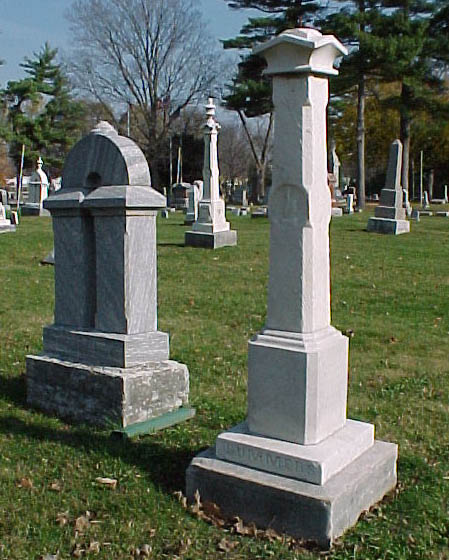 |
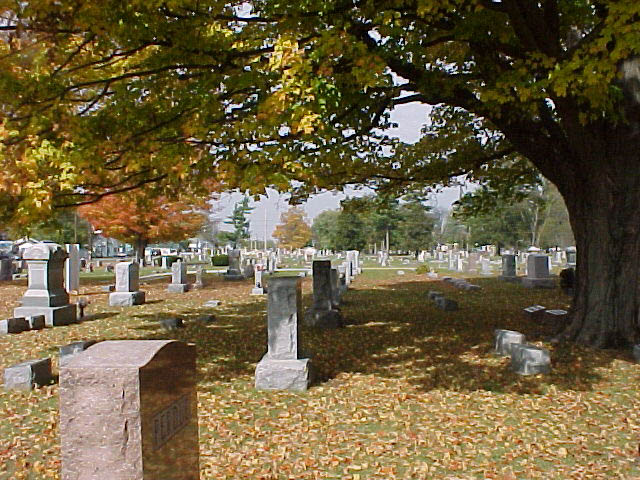 |
|
In March of 1908, the Park View Cemetery Association began operations along the Anderson-Alexandria Pike (SR 9) across 6th Street immediately south of the IOOF Cemetery. Park View used the same basic design with trees and curving drives, eventually even having to cross the little stream that runs through both burial grounds. So harmonious are the two cemeteries in appearance that the casual onlooker may assume they are one large entity--an attractive site for the busy work-a-day world. This view is taken from Park View looking north. The stones in the background are those of the IOOF. |
Click here for a list in pdf format of burials with headstones.